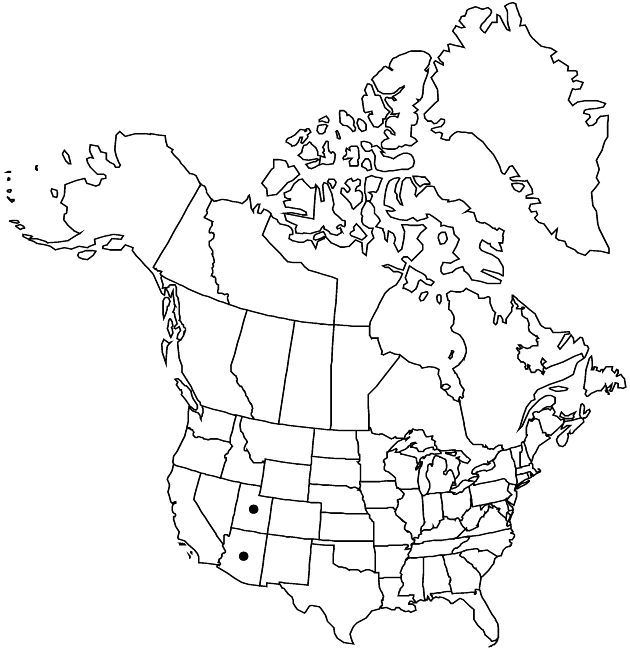Difference between revisions of "Chrysothamnus scopulorum"
Sida 21: 1626. 2005.
FNA>Volume Importer |
GeoffLevin (talk | contribs) m (Corrected accepted name authorities to match printed version) |
||
| (7 intermediate revisions by 2 users not shown) | |||
| Line 1: | Line 1: | ||
{{Treatment/ID | {{Treatment/ID | ||
|accepted_name=Chrysothamnus scopulorum | |accepted_name=Chrysothamnus scopulorum | ||
| − | |accepted_authority=(M. E. Jones) Urbatsch | + | |accepted_authority=(M. E. Jones) Urbatsch, R. P. Roberts & Neubig |
|publications={{Treatment/Publication | |publications={{Treatment/Publication | ||
|title=Sida | |title=Sida | ||
| Line 8: | Line 8: | ||
}} | }} | ||
|common_names=Grand Canyon glowweed or evening-daisy | |common_names=Grand Canyon glowweed or evening-daisy | ||
| − | |basionyms={{Treatment/ID/ | + | |special_status={{Treatment/ID/Special_status |
| + | |code=E | ||
| + | |label=Endemic | ||
| + | }} | ||
| + | |basionyms={{Treatment/ID/Basionym | ||
|name=Bigelowia menziesii var. scopulorum | |name=Bigelowia menziesii var. scopulorum | ||
|authority=M. E. Jones | |authority=M. E. Jones | ||
| + | |rank=variety | ||
| + | |publication_title=Proc. Calif. Acad. Sci., ser. | ||
| + | |publication_place=2, 5: 692. 1895 (as Bigelovia) | ||
}} | }} | ||
|synonyms={{Treatment/ID/Synonym | |synonyms={{Treatment/ID/Synonym | ||
|name=Haplopappus scopulorum | |name=Haplopappus scopulorum | ||
|authority=(M. E. Jones) S. F. Blake | |authority=(M. E. Jones) S. F. Blake | ||
| − | }}{{Treatment/ID/Synonym | + | |rank=species |
| + | }} {{Treatment/ID/Synonym | ||
|name=Haplopappus scopulorum var. hirtellus | |name=Haplopappus scopulorum var. hirtellus | ||
|authority=S. F. Blake | |authority=S. F. Blake | ||
| − | }}{{Treatment/ID/Synonym | + | |rank=variety |
| + | }} {{Treatment/ID/Synonym | ||
|name=Hesperodoria scopulorum | |name=Hesperodoria scopulorum | ||
| − | |authority= | + | |authority= |
| + | |rank=species | ||
}} | }} | ||
|hierarchy=Asteraceae;Asteraceae tribe Astereae;Chrysothamnus;Chrysothamnus scopulorum | |hierarchy=Asteraceae;Asteraceae tribe Astereae;Chrysothamnus;Chrysothamnus scopulorum | ||
| Line 44: | Line 54: | ||
-->{{#Taxon: | -->{{#Taxon: | ||
name=Chrysothamnus scopulorum | name=Chrysothamnus scopulorum | ||
| − | + | |authority=(M. E. Jones) Urbatsch, R. P. Roberts & Neubig | |
| − | |authority=(M. E. Jones) Urbatsch | ||
|rank=species | |rank=species | ||
|parent rank=genus | |parent rank=genus | ||
| Line 58: | Line 67: | ||
|publication title=Sida | |publication title=Sida | ||
|publication year=2005 | |publication year=2005 | ||
| − | |special status= | + | |special status=Endemic |
| − | |source xml=https:// | + | |source xml=https://bitbucket.org/aafc-mbb/fna-data-curation/src/2e0870ddd59836b60bcf96646a41e87ea5a5943a/coarse_grained_fna_xml/V19-20-21/V20_415.xml |
|tribe=Asteraceae tribe Astereae | |tribe=Asteraceae tribe Astereae | ||
|genus=Chrysothamnus | |genus=Chrysothamnus | ||
Latest revision as of 13:12, 7 March 2024
Shrubs, 30–100 cm; with woody, ± wandlike, branched caudices, bark tan to gray, fairly smooth, flaky with age. Stems ascending, green, becoming tan, glabrous or puberulent. Leaves ascending to spreading; sessile; blades usually 5-nerved, linear to narrowly elliptic or lanceolate, 7–80 × 1–12 mm, flat, margins often ciliolate, apices attenuate to spinulose, faces glabrous or scabrellous. Heads in usually cymiform to corymbiform, rarely racemiform arrays, not overtopped by distal leaves. Involucres obconic to subcylindric, 6.5–12 × 3–5 mm. Phyllaries 50–60+ in 5–6(–7) series, ± in spirals, tan, midnerves greenish to brown, raised, ± expanded apically, oblong to elliptic, 1–8.5 × 1–2 mm, unequal, mostly chartaceous, apices acute to rounded, erect, ± thickened, faces glabrous, not resinous. Disc florets 10–16(–20); corollas 5.5–8 mm, lobes 1.5–2.3 mm; style branches 2.8–3.7 mm, appendages 1.4–1.9 mm. Cypselae reddish brown, cylindric, 4–6 mm, ± 4-angled, faces hairy; pappi tan, 6–7.5 mm. 2n = 18 (as Haplopappus scopulorum).
Phenology: Flowering late summer–fall.
Habitat: Brushy mountain slopes, ponderosa pine communities
Elevation: 1200–2200 m
Discussion
Selected References
None.
